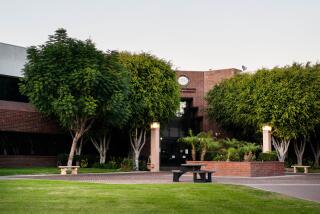Far More Than Just a Hospital
- Share via
We often have important people to lunch at The Times, in a sixth floor dining room well above the daily combat of the newsroom.
These are polite affairs. The guest is generally tossed mild questions by editors, editorial writers and reporters. Even the fiercest of reporters reduce their intensity level a few notches. Good silverware does that to you.
Our guests are equally polite. If they have a grievance against the paper, they usually keep it to themselves.
Not Dr. Reed V. Tuckson, president of the Charles R. Drew University of Medicine and Science, which is closely affiliated with the Los Angeles County-run Martin Luther King Jr./Drew Medical Center.
King/Drew, serving areas of south Los Angeles County that are predominantly African American and Latino, has been taking a pounding the last few years, accused of medical and managerial incompetence and of poor race relations.
The Times has recorded a number of serious failures at the hospital, including the transfusion of HIV-tainted blood from the blood bank, revelations about doctors allegedly engaged in excessive moonlighting and a finding of discrimination by African American administrators. Officials have been outraged. Los Angeles County Supervisor Yvonne Brathwaite Burke, an African American who represents South L.A., has initiated a “swift and decisive” reorganization to protect patients and “establish a level of operational stability.”
Tuckson, who has been at Drew for five years, seemed to remember every one of those stories. No dining room deference for The Times from this 45-year-old man who spoke with a deep, insistent voice loud enough to bounce off the walls.
The coverage was unfair, he said. Why, he asked, doesn’t anyone investigate the other county hospitals? “We get hammered unmercifully,” he said. “What the heck is going on here?”
*
His intensity reflected the deep emotions touched off by any criticism of King/Drew, a hospital whose history is woven into the fabric of Los Angeles’ African American community.
To better understand Tuckson’s fury, I wanted to hear that history, preferably from someone who was there from the beginning. So on Friday, with his words still ringing in my ears, I drove east on the Century Freeway and headed a few blocks south to the hospital.
I looked for someone who could explain what King/Drew means to the community.
The director of volunteer services, Bernadette Bowman, directed me to the gift shop, where I found one of the hospital’s original volunteers, Wilhelmina Shamberger, founder of the King-Drew Medical Center Auxiliary.
Shamberger is an older woman who has lived in south L.A. County’s black community for more than half a century.
“The hospital means everything,” she said. “It’s a long-needed facility from way back.”
Up to 1972, when King/Drew was dedicated, there were no hospitals in Watts, Willowbrook or any other South L.A. communities, she recalled.
“There was a time when anything happened to you in this area, they had to take you to the Georgia Street Receiving Hospital and if it was serious enough, they would transfer you to General Hospital,” she said.
The Georgia Street hospital, near the present Convention Center, was more than 10 miles from Watts. General Hospital (Los Angeles County-USC Medical Center) is about five miles from there, on the Eastside, across the Los Angeles River.
If you were badly injured, chances of survival were minimal after traveling those distances.
This was a festering source of community anger. In fact, the McCone Commission investigation of the 1965 Watts riots said it was a cause of the uprising.
Shamberger was a community leader. She had been active in PTA and was a Head Start organizer in the ‘60s. “People knew me,” she said.
Federal money was pouring into post-riots Watts. “I said, ‘What we really need is a hospital, that’s what we really need,’ ” she recalled. Other community leaders agreed. So did the powerful county supervisor of the era, Kenny Hahn.
Hahn, with connections ranging from the White House to the County Hall of Administration, got the money. The site was an old World War II housing project, Palm Lane. But Palm Lane couldn’t be torn down unless residents of the area agreed.
Shamberger organized a survey, and got the votes to replace the project with the hospital. A lot of her friends in the project were angry with her at the time, she said, but were able to move to better homes with the help of federal relocation funds. “Many of them, and their children and grandchildren, now appreciate it,” she said.
*
When the hospital was built, it was largely a black-run institution, serving a predominantly black population. Today, the area has changed. Many neighborhoods in South L.A. are Latino.
Still, African Americans are the biggest ethnic group on the staff. Tuckson, its president, is black. And of the King/Drew medical faculty, which serves the hospital, 47% are African American, 30% white, 14% Asian, 5% Latino and 4% Filipino.
To generations of King/Drew volunteers, and many other African Americans, the facility is “our hospital,” a place that provided medical care where there was none, an institution that offered medical training to blacks when other places turned them away.
So when county officials begin reorganizing King/Drew, they will be up against tradition and symbolism as well as the community’s enormous need for the hospital.
Maybe that’s why Tuckson seemed more interested in talking than eating when he came to lunch.
More to Read
Sign up for Essential California
The most important California stories and recommendations in your inbox every morning.
You may occasionally receive promotional content from the Los Angeles Times.













